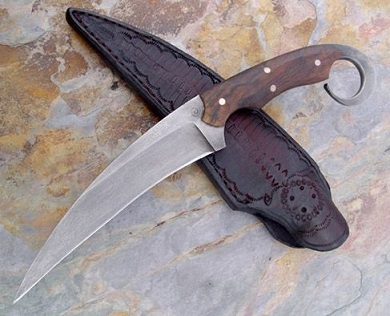Karambit: Difference between revisions
No edit summary |
No edit summary |
||
| (One intermediate revision by the same user not shown) | |||
| Line 1: | Line 1: | ||
;[[Knife]] | ;[[Knife]] | ||
[[]] | [[File:Knife karambit.jpg]] | ||
<br> | |||
<br> | |||
'''Description:''' The karambit is a small Southeast Asian hand-held, curved knife resembling a claw. Known as kerambit in its native Indonesian and Malay, it is called karambit in the Philippines. | |||
'''History:''' The karambit is believed to have originated among the Minangkabau people of West Sumatra where, according to folklore, it was inspired by the claws of big cats. As with most weapons of the region, it was originally an agricultural implement designed to rake roots, gather threshing and plant rice. As it was weaponised, the blade became more curved to maximize cutting potential. Through Indonesia's trade network and close contact with neighboring countries, the karambit was eventually dispersed through what are now Cambodia, Laos, Malaysia, Myanmar, Thailand and the Philippines. | |||
Culturally the karambit was a subject of condescension in Java because of its history as a weapon of the agrarian peasantry, as opposed to the kesatria (warrior class) who were trained in the keraton or palace. European accounts tell that soldiers in Indonesia were armed with a kris at their waist or back and a spear in their hands, while the karambit was used as a last resort when the fighter's other weapons were lost in battle. Nevertheless it was popular among women who would tie the weapon into their hair to be used in self-defense. Even today, Silat practitioners regard it as a feminine weapon. The renowned Bugis warriors of Sulawesi were famous for their embrace of the karambit. Today it is one of the main weapons of Silat and is commonly used in Filipino martial arts as well. | |||
Superficially the karambit resembles the jambiyah but there is no connection. The jambiyah was always designed as a weapon and serves as a status marker, often made by skilled artisans and jewelers using precious stones and metals, whereas the karambit was and still remains an unadorned, modest farmer's implement and useful utility knife. | |||
'''Technique:''' The karambit is held with the blade pointing downward from the bottom of the fist, either curving forwards or backwards. While it is primarily used in a slashing or hooking motion, karambit with a finger ring are also used in a punching motion hitting the opponent with the finger ring. Some karambit are designed to be used in a hammering motion. This flexibility of striking methods is what makes it so useful in self-defense situations. The finger guard makes it difficult to disarm and allows the knife to be maneuvered in the fingers without losing one's grip. | |||
The short Filipino karambit has found some favor in the West because such proponents allege the bio-mechanics of the weapon allow for more powerful cutting strokes and painful "ripping" wounds, and because its usability is hypothesized as more intuitive, though there continues to be debate about this matter. | |||
Latest revision as of 00:18, 18 November 2014

Description: The karambit is a small Southeast Asian hand-held, curved knife resembling a claw. Known as kerambit in its native Indonesian and Malay, it is called karambit in the Philippines.
History: The karambit is believed to have originated among the Minangkabau people of West Sumatra where, according to folklore, it was inspired by the claws of big cats. As with most weapons of the region, it was originally an agricultural implement designed to rake roots, gather threshing and plant rice. As it was weaponised, the blade became more curved to maximize cutting potential. Through Indonesia's trade network and close contact with neighboring countries, the karambit was eventually dispersed through what are now Cambodia, Laos, Malaysia, Myanmar, Thailand and the Philippines.
Culturally the karambit was a subject of condescension in Java because of its history as a weapon of the agrarian peasantry, as opposed to the kesatria (warrior class) who were trained in the keraton or palace. European accounts tell that soldiers in Indonesia were armed with a kris at their waist or back and a spear in their hands, while the karambit was used as a last resort when the fighter's other weapons were lost in battle. Nevertheless it was popular among women who would tie the weapon into their hair to be used in self-defense. Even today, Silat practitioners regard it as a feminine weapon. The renowned Bugis warriors of Sulawesi were famous for their embrace of the karambit. Today it is one of the main weapons of Silat and is commonly used in Filipino martial arts as well.
Superficially the karambit resembles the jambiyah but there is no connection. The jambiyah was always designed as a weapon and serves as a status marker, often made by skilled artisans and jewelers using precious stones and metals, whereas the karambit was and still remains an unadorned, modest farmer's implement and useful utility knife.
Technique: The karambit is held with the blade pointing downward from the bottom of the fist, either curving forwards or backwards. While it is primarily used in a slashing or hooking motion, karambit with a finger ring are also used in a punching motion hitting the opponent with the finger ring. Some karambit are designed to be used in a hammering motion. This flexibility of striking methods is what makes it so useful in self-defense situations. The finger guard makes it difficult to disarm and allows the knife to be maneuvered in the fingers without losing one's grip.
The short Filipino karambit has found some favor in the West because such proponents allege the bio-mechanics of the weapon allow for more powerful cutting strokes and painful "ripping" wounds, and because its usability is hypothesized as more intuitive, though there continues to be debate about this matter.